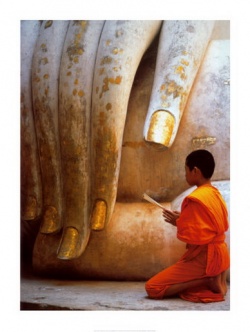Manual of Vinaya - Reading Ten: Description of the Medium and Greater Capacities
The following reading consists of the third major section of the Song of My Spiritual Life (Nyam mgur) of Je Tsongkapa (1357-1419).
This text is also known as The Short Book on the Steps of the Path (Lam-rim bsdus-don).
Accompanying the verses of Je Tsongkapa’s root text is a commentary called Illumination of the Essence (Snying-po mdor-bsdus gsal-ba), composed by Choney Lama Drakpa Shedrup (1675-1748).
THE PATH SHARED WITH PEOPLE OF MEDIUM CAPACITY
The method for putting into practice the steps of the path shared with people of medium capacity has two parts: the reasons why it is necessary to contemplate what’s wrong with the truth of suffering and the truth of the source of suffering; and then the actual contemplation.
WHY YOU MUST CONTEMPLATE WHAT’S WRONG WITH THE FIRST TWO TRUTHS
The reasons why it is necessary to contemplate what’s wrong with the truths of suffering and its source are indicated in the following verse of the root text:
(15a)
If you don’t make efforts to contemplate
what’s wrong with the truth of suffering,
You won’t be able to develop as you should
the aspiration to be free.
And if you don’t think of how the truth of the source
throws you into the cycle of life,
Then you won’t understand the way to cut
the cycle of suffering from its root.
From the very beginning, those who wish to free themselves from cyclic existence must contemplate what’s wrong with the truth of suffering and the truth of the source of suffering. The truth of suffering includes both the general sufferings of the three lower realms and the higher realms, as well as the specific sufferings of birth, old age, aging, sickness, death, and so on. If you don’t make great efforts to contemplate what’s wrong with this cycle of suffering, then you will not get any great wish to be free from suffering, and you will not be able to develop the state of mind in which you aspire toward freedom in the way that you should.
You must understand the details of the nature of desire and the other (mental afflictions), and how they develop, because if you don’t think about how the truth of the source of suffering acts to throw you into the cycle of life, then you won’t understand how to cut the very root of the cycle of suffering. It would be like shooting an arrow at a target you can’t see.
THE ACTUAL CONTEMPLATION
The actual contemplation on the problems of the first two truths has two parts: the contemplation on the truth of suffering—the problems of the cycle of life, and the contemplation on the truth of the source of suffering—how it is that we are thrown into this cycle of life.
The Contemplation on the Truth of Suffering
These lines of the root text indicate the contemplation of the truth of suffering:
(15b)
With a solid disgust for this existence
that definitely wants to get out,
Look at all of the suffering in this circle of life; look at birth, aging, sickness and death, at grief and crying out in pain, at our mental unhappiness, at the heat and the cold, all the fighting, and on and on. Then with a fierce and solid disgust for this existence that definitely wants to get out of the cycle of suffering you must try to understand the cause which creates this suffering, as it will be explained later in the text.
The Contemplation on the Truth of the Source
The contemplation on the truth of the source of suffering is expressed here in the root text:
(15c)
Finding out about this suffering cycle
should be treated with great concern.
put this into practice;
You, who seek for freedom, must
try to practice this way.
Finding out about what chains you to this suffering cycle should be treated as something extremely important and with great concern. You are chained by both your deeds and your bad thoughts. If we were to divide these out into all of their different forms, there would be a great many of them. To state it in a nutshell, the mental afflictions in the mindstream of a common person—that is, desire, anger, pride, ignorance, bad forms of doubt, jealousy, and so on—are all the truth of the source of suffering in the form of mental afflictions, and the deeds which are motivated by them—both virtuous and non-virtuous—are the truth of the source of suffering in the form of deeds. It is mainly because of our ignorance that we collect these deeds, and it is because of the deeds themselves that we are thrown into the cycle of life. We must gain a good understanding of all the steps in the twelve links of dependent origination, through which this process takes place.
To put it briefly, you must rely on the personal instructions of a spiritual guide, and thus come to realize how it is that your deeds and your bad thoughts make you circle around in this cycle of life. Then you will understand the truth of the source—the process through which you are thrown into cyclic life.
The way to cut the very root of this cycle is with the wisdom which perceives the lack of a “self.” You use this wisdom to invalidate the object in which ignorance believes, and by the time you familiarize yourself with this process fully you are able to eliminate this ignorance, and thus cut the root of the cycle of suffering. When ignorance is eliminated, all the other mental afflictions are by the way removed themselves.
If between the pair of the truth of suffering and the truth of the source of suffering you are able to eliminate the truth of the source, then you will also be able to remove the truth of the source of suffering; if you cut the root of the plant, for example, the plant itself dies.
Although this is the ultimate intent of the great scriptures, us spiritual beginners nowadays are unable to eliminate our mental afflictions from their root. It is therefore a very crucial point that we eliminate that part of the source of suffering which is composed of our bad deeds and downfalls by using the method of purification which involves the four forces.
Most especially we have to exert ourselves in the three trainings of morality, (concentration, and wisdom.] The principal element involved in the training of morality is the state of mind which wants to give up performing the ten bad deeds. The principal element in the training of concentration is the high meditative state called quietude, however it is not the only element involved. The mental ability to place your mind one-pointedly for any length of time you desire on some kind of pure or virtuous object is also included into the training of concentration.
The main element in the training of wisdom is what we call “special vision,” although it is not the only thing involved. Also included in the training of wisdom is the intelligence which is able to examine, in a thorough way, the correct reasonings which examine any of the varying levels of the lack of “self”, as well as the kinds of wisdom which examine the meanings of any Buddhist texts or teachings.
THE ACTUAL PATH FOR PEOPLE OF GREATER CAPACITY
The method for putting into practice the steps of the path for people of greater capacity has two parts: developing the wish for enlightenment which is the basis for bodhisattva activities, and then training yourself in the activities themselves.
THE WISH FOR ENLIGHTENMENT
The explanation of the with for enlightenment, the basis of a bodhisattva’s activities, includes two sections.
Special Features or Benefits of the Wish for Enlightenment
First I will explain the special features, or benefits of the wish for enlightenment, as expressed in the following lines of the root text:
(16a)
The wish for enlightenment is the central beam
which holds up the supreme way’s path;
It’s also the foundation and the basis
of a bodhisattva’s mighty activity.
It is like the elixir of an alchemist
for both of the two great masses,
And a treasury of merit containing the collections
of a myriad number of virtues.
The wish for enlightenment as it is found in the greater way is like the central beam which holds up the path of the supreme way. It is the foundation and basis which allows the mighty bodhisattva activities of giving, and the rest of the six perfections, and other such activities to come into being, to remain, and likewise to increase.
Like an alchemical elixir that acts to transform a piece of ordinary iron into gold, this wish transforms both of the two great masses of merit and wisdom into total enlightenment. It is also a great treasury which contains many great collections of a myriad number of virtues.
In his text, Je Tsongkapa not only indicates the reasons why we must develop the wish for enlightenment, but with the words “foundation and basis” he also shows us that this wish for enlightenment as it is found in the greater way is the very door for entering the path of the greater way.
See also
- Manual of Vinaya - Reading One: Je Tsongkapa’s Epistle on Ethics
- Manual of Vinaya - Reading Two: Outline of the Sutra on Discipline (Vinaya Sutra)
- Manual of Vinaya - Reading Three: Introduction to the Vows of Individual Freedom
- Manual of Vinaya - Reading Four: A General Description of the Vows, Part One
- Manual of Vinaya - Reading Five: A General Description of the Vows, Part Two
- Manual of Vinaya - Reading Six: Taking and Keeping the Vows
- Manual of Vinaya - Reading Seven: The Ten Non-Virtues, and their Karmic Results
- Manual of Vinaya - Reading Eight: Introduction to the Steps of the Path
- Manual of Vinaya - Reading Nine: Description of the Lesser Capacity
- Manual of Vinaya - Reading Ten: Description of the Medium and Greater Capacities
- Manual of Vinaya - CLASS NOTES part 1
- Manual of Vinaya - CLASS NOTES part 2


